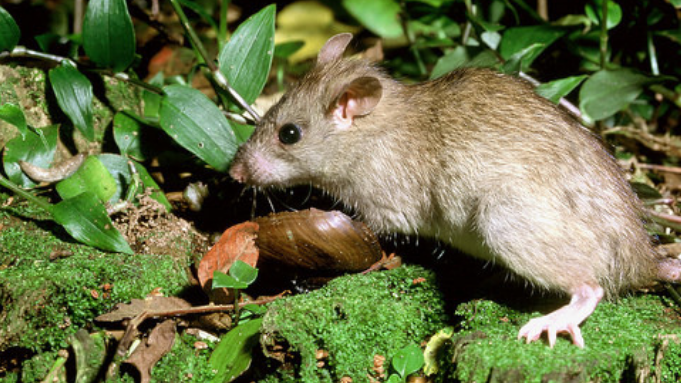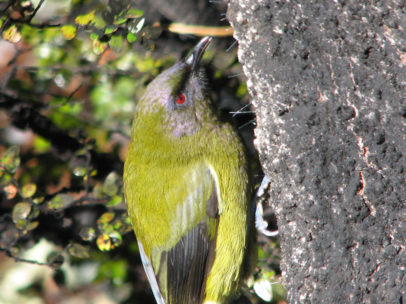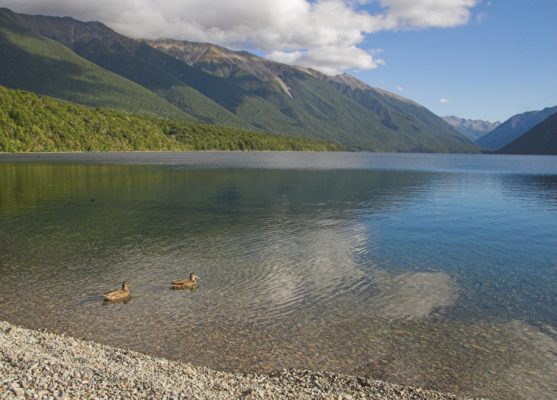Ship rats are known to be good and climbing trees – but what are they like at climbing mountains? If our climate gets warmer, might rats go to new heights in the search for new territory and food?

Scientists Jennifer Christie and Graeme Elliott from DOC’s Christchurch office, along with Peter Wilson and Rowley Taylor from Landcare Research, Nelson looked at how elevation affects the distribution of ship rats in an article published last year in the New Zealand Journal of Ecology. The study was carried out at Mt Misery, in Nelson Lakes National Park, from 1974 to 1993. Ship rats (Rattus rattus) were captured in traps set along a 2 km elevational transect (455–1585 m a.s.l.) in beech (Nothofagaceae) forest and adjacent alpine tussock, with a total of 118 rats captured.
“Establishing whether there is a link between ship rat elevational distribution and temperature is important, because in the next 100 years temperatures are predicted to increase as a result of climate change. A temperature-induced increase in ship rat elevational distribution may negatively impact native species that have persisted at higher elevations and are vulnerable to being preyed on by ship rats.”
Timeframes
But temperatures changes occur slowly. To see if climate change temperature rises are having an effect and equally long study of rat distribution is needed.
“Ascertaining whether a relationship between ship rat presence, elevation and temperature exists, requires datasets with a long temporal extent, collected across an elevational gradient. Information on historical patterns of ship rat distribution is also desirable, so that comparisons with current and future distributions can be made. Very few long-term records of ship rat capture programmes exist, especially prior to 1999. Records from sites such as Cupola Basin, Craigieburn and the Orongorongo Valley suggest ship rats were rare or nonexistent in high elevation silver and mountain beech forest prior to 1999. However, trapping was generally for only short time periods and did not extend into the alpine zone.”
Fortunately one early study did record the data needed, although at the time it was done, it was mice and stoats that were being studied and the rat capture data was recorded, but not used.

“A long-term study at Mt Misery summarised changes in the number of mouse and stoat captures across an elevational gradient in relation to beech seed production and season, between 1974 and 1993, but did not include ship rat capture results even though these data were collected. Since 1999, ship rats have been recorded as by-catch in stoat trapping operations in alpine habitats and analyses have shown a negative relationship between ship rats and increasing elevation.”
The researchers aimed to identify what drives ship rat capture over an elevation gradient in a South Island beech forest and also to use the early rat collection data as a baseline for future comparisons as predicted climate-change temperature rises occur.
“We use logistic regression to analyse the influence of elevation, beech seed production, mean winter temperature and precipitation on annual ship rat capture.”
Current climatic conditions
So what is life like for rats living on the slopes of Mt Misery?
“Mt Misery is located between two glaciated valleys at the head of Lake Rotoroa in Nelson Lakes National Park, in the South Island of New Zealand (41°55’S, 172°39’E). The study site is a truncated spur on the north western side of the peak, encompassing cold-temperate southern beech (Nothofagaceae) rain-forest and alpine grasslands, from Lake Rotoroa (455 m a.s.l.) to the top of Mt Misery (1585 m a.s.l). The climate is cold and wet. At the nearby (~20 km northeast) Lake Rotoiti weather station (620 m a.s.l.) precipitation varied between 1100 and 1900 mm per year. Mean daily maximum temperatures in summer range from 18.7° to 20.9°C, and in winter from 8.3° to 9.7°C. While mean daily minimum temperatures usually range from 7.5° to 8.4°C in summer and -1.9° to -0.6°C in winter.
So Mt Misery winters can be cold and the climate wet – potentially miserable conditions for rats. There is, however, the advantage of beech seed fall, particularly in masting years.
Research methods
“Twenty 0.28 m2 trays were used to measure annual beech seed production every year except for 1986 and 1987. Ship rats were trapped on a single line containing 100 trap sites at 50 m intervals up a truncated spur (455–1585 m a.s.l.). At each trap site, one mouse and one rat snap trap were set inside a metal tunnel with an entrance at each end. Traps were baited with a mixture of peanut butter and rolled oats, and set for three consecutive nights at the end of February (summer), May (autumn), August (winter) and November (spring) from May 1974 until February 1984. Between 1984 and 1990, the traps were only set in February and May 1986. Quarterly trapping resumed from February 1990 until May 1993, but only for the traps below the tree line, with breaks occurring in May and August 1992.”
Rats were also caught in traps intended for stoats.
“At every fourth trap site paired Fenn traps were set (i.e. 200 m spacing, 25 paired sets in total) to trap stoats. These were set at the same time and for the same number of nights as the rat snap traps and also caught rats. Because of the low number of captures, ship rat capture data from all three trap types were included in the analysis, even though these traps may vary in their effectiveness.”
Modelling

Mathematical modelling was used to determine which predictors best determined ship rat capture at each trap site, each year.
“The analysis examined the possible effects of beech seed production, elevation, winter temperature and total annual precipitation on ship rat capture… A total of 118 ship rats were captured between 1974 and 1993. Only small numbers of ship rats were captured each year, and captures varied among years (range = 3–15 rats).”
Beech seed production
There were no full beech masts during the study period.
“Annual beech seed production also varied among years, with no full masts (>4000 seeds per m2) detected in the 18 years of beech seed records. There were only 2 years with partial masts (500–4000 seeds per m2), 7 years with poor masts (<500 seeds per m2), and 9 years with no seed production.”
Not surprisingly, more rats were captured following years where beech seedfall was high.
“In the 15 years with both rat capture and beech seed production data, higher numbers of rats were captured in the austral year directly following a year with beech seed compared to years where no beech seed was produced in the preceding year. The elevation of capture also varied according to whether beech seed had been produced, with more ship rats captured and at higher elevations in years with beech seed produced. No ship rats were captured above the red beech elevational limit (approx. 1030 m a.s.l.), so they were not detected in the higher elevation mountain and silver beech forest (1050–1410 m a.s.l.), and alpine habitats (1425–1585 m a.s.l.).”
So what did the mathematical modelling make of it all?
Rat capture influences
“According to the best two models, rat capture was strongly influenced by the positive effects of beech seed production, as well as the negative effect of increasing elevation. Model 1 also suggests there was some evidence to show that the negative effects of increasing winter temperatures, as well as total annual precipitation, may also influence rat capture. This indicates further investigation into the effects of winter temperatures and precipitation on ship rat capture is warranted.”
In the study period, 1974-1999, no ship rats were found in the Mt Misery alpine zone, good news for alpine birds, reptiles and invertebrates – historically at least.
“At Mt Misery no ship rats were caught above the red beech tree elevational limit (~1030 m a.s.l.) despite extensive long term trapping. This is consistent with evidence that ship rats are absent from alpine habitats in New Zealand.”
But times – and temperatures – may be changing.
Future prospects
“Ship rats are habitat generalists and based on previous records in these types of habitats are capable of occupying high elevation silver and mountain beech forest and alpine tussock. Ship rats live entirely in silver tussock grassland on the sub-antarctic Macquarie Island and recent anecdotal evidence from trapping operations suggests they are present in the New Zealand alpine zone at certain sites which would be comparable ecologically with Mt Misery. Furthermore, male ship rats have been recorded moving distances of up to 790 m in a night in beech forest, so should be capable of living in the forest and commuting into the alpine zone.”
It will be something to keep an eye on with future studies.
“Our analyses provide an important insight into the drivers of ship rat elevational distribution, as well as providing a benchmark for comparing both current and future ship rat elevational distributions. Interrogation of more recent rat monitoring data from a range of beech forest types and sites is needed to test hypotheses around how warming temperatures, as predicted with climate change, will both directly and indirectly effect ship rat distribution.”
The full research report is published in the New Zealand Journal of Ecology and is freely available online.
How elevation affects ship rat (Rattus rattus) capture patterns, Mt Misery, New Zealand (2016)

